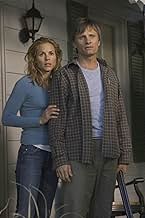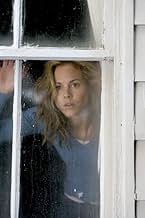Un homme aux manières douces devient un héros local par un acte de violence qui génère des répercussions qui ébranleront sa famille.Un homme aux manières douces devient un héros local par un acte de violence qui génère des répercussions qui ébranleront sa famille.Un homme aux manières douces devient un héros local par un acte de violence qui génère des répercussions qui ébranleront sa famille.
- Nommé pour 2 Oscars
- 37 victoires et 84 nominations au total
Histoire
Le saviez-vous
- AnecdotesFor the sex scene on the stairs, David Cronenberg was concerned about the two actors getting hurt on the hard wooden steps. He asked his stunt man whether or not he had any stunt pads to soften up the stairs. The stunt man laughed, saying that in the twenty years he had been working as a stunt man, no director had ever asked him for stunt pads for a sex scene. Pads were not used for most of the scene however, and in the shot when Edie is naked on the bed with bruises visible on her back, make-up was used to hide the amount of bruises that Maria Bello received from the scene.
- GaffesIn the high school softball game, the bully comes up to the plate carrying a wooden bat, but the sound heard when he hits the ball is the sound of an aluminum bat.
- Citations
[last lines]
Richie Cusack: [Joey holds a gun to Richie's head] Jesus, Joey.
Tom Stall: [as Joey shoots Richie in the head, then stands over his dead body] Jesus, Richie.
- Versions alternativesThere are some minute differences between the US and the International version when it comes to some of the violent scenes:
- Fogarty's thug, who gets his nose smashed into his skull has more blood spurt out in the International version in the shot where he is dying on the ground.
- When Joey stomps on Richie's thug's throat, he spits blood (instead of it 'welling up') and the sound effect of the neck breaking is louder. Both shots last the same length of time and use the same take, the amount of blood was simply toned down digitally for the MPAA. Most video versions outside the U.S. use the 'international version' but the shots appear in the supplements on the U.S. DVD (In the featurette titled 'Violence's History', Cronenberg shows the U.S. and international cut scenes side by side and explains the reason why there wasn't a standard 'unrated' version in the U.S. was because the changes were so small).
- ConnexionsEdited into A History of Violence: Deleted Scene - Scene 44 (2006)
Commentaire à la une
Cronenberg's adaptation of a Wagner and Locke graphic novel places a simple American family man, and his all-American family, into a new and disturbing context which has them questioning everything they think they know. Tom Stall (Viggo Mortensen) owns a little diner in a small town and has a nice house on the outskirts of town, where he and his wife Edie (Maria Bello) raise their two kids apparently living the American dream in their own way. One day at the diner, two murderers pop by at closing time for some cherry pie, and Tom's heroic defense of his diner, his customers and himself sets off a series of events that threaten his family, his sanity and his life. The eerie tension never lets up in this powerful examination of identity, honesty and violence.
David Cronenberg has directed some of my favorite off-beat films - the masterpiece Naked Lunch, Scanners, Videodrome. I have watched these films many times and I still find them interesting. I can't really call myself a fan, however, because there are also just as many Cronenberg films out there which I found difficult to get through the first time (Crash, eXistenZ, Dead Ringers). Cronenberg enjoys creating disturbing situations and imagery, and wants to get under your skin and to stimulate your mind on as many levels as he can. In most cases, he pulls it off masterfully, but sometimes, his emphasis on the bizarre can come across as pretentious and forced.
Like a lot of very creative and intelligent people, Cronenberg sometimes leaves his signature virtually everywhere in his work. And sometimes, a director needs to make a film which does everything they want to accomplish but leaves off the signature. For example - the brilliant David Lynch showed us his ability to jump out of his own skin with Elephant Man and The Straight Story. These are still very much Lynch films, but they also appeal to the wider audience of mainstream cinema-goers. A History of Violence is, in some ways, Cronenberg's most straightforward film. A key to its success is that it is very easy to forget that you are watching a Cronenberg film, no matter how aware you are of Cronenberg's many quirks, idiosyncrasies and trademarks. It is so masterfully directed that, although the plot is not entirely unpredictable, you are right there in the action with the characters and feeling what they feel so that, though you may know what's next, you never exactly see it coming and you never know how it will take you there.
Viggo Mortensen, in his best mainstream role since Aragorn, and Maria Bello (one of the actors who made The Cooler worth watching), head an impressive cast in this adaptation of a Wagner and Locke graphic novel. Nobody in the cast slips up at all. The script is intense, realistic, and probably did nothing to make the performances easy. The plot, if described without the plot and the context created by the script, would seem somewhat absurd, but like Woody Allen's Match Point, it's absurdity does not make it impossible to believe. Editing, directing and pure performance combine to make flawless performances for this cast. Backed up by veterans Ed Harris and William Hurt, and very strongly supported by the excellent Maria Bello, Mortensen is shockingly excellent in a difficult role. I can't explain why without giving too much of the film away. Although the rest of the cast did exactly as they were supposed to, I want to single out Ashton Holmes - an actor I was completely unfamiliar with but who I will look out for in the future.
I recommend A History of Violence highly. It is one of my top five reasons for considering 2005 to have been a great year in North American film.
David Cronenberg has directed some of my favorite off-beat films - the masterpiece Naked Lunch, Scanners, Videodrome. I have watched these films many times and I still find them interesting. I can't really call myself a fan, however, because there are also just as many Cronenberg films out there which I found difficult to get through the first time (Crash, eXistenZ, Dead Ringers). Cronenberg enjoys creating disturbing situations and imagery, and wants to get under your skin and to stimulate your mind on as many levels as he can. In most cases, he pulls it off masterfully, but sometimes, his emphasis on the bizarre can come across as pretentious and forced.
Like a lot of very creative and intelligent people, Cronenberg sometimes leaves his signature virtually everywhere in his work. And sometimes, a director needs to make a film which does everything they want to accomplish but leaves off the signature. For example - the brilliant David Lynch showed us his ability to jump out of his own skin with Elephant Man and The Straight Story. These are still very much Lynch films, but they also appeal to the wider audience of mainstream cinema-goers. A History of Violence is, in some ways, Cronenberg's most straightforward film. A key to its success is that it is very easy to forget that you are watching a Cronenberg film, no matter how aware you are of Cronenberg's many quirks, idiosyncrasies and trademarks. It is so masterfully directed that, although the plot is not entirely unpredictable, you are right there in the action with the characters and feeling what they feel so that, though you may know what's next, you never exactly see it coming and you never know how it will take you there.
Viggo Mortensen, in his best mainstream role since Aragorn, and Maria Bello (one of the actors who made The Cooler worth watching), head an impressive cast in this adaptation of a Wagner and Locke graphic novel. Nobody in the cast slips up at all. The script is intense, realistic, and probably did nothing to make the performances easy. The plot, if described without the plot and the context created by the script, would seem somewhat absurd, but like Woody Allen's Match Point, it's absurdity does not make it impossible to believe. Editing, directing and pure performance combine to make flawless performances for this cast. Backed up by veterans Ed Harris and William Hurt, and very strongly supported by the excellent Maria Bello, Mortensen is shockingly excellent in a difficult role. I can't explain why without giving too much of the film away. Although the rest of the cast did exactly as they were supposed to, I want to single out Ashton Holmes - an actor I was completely unfamiliar with but who I will look out for in the future.
I recommend A History of Violence highly. It is one of my top five reasons for considering 2005 to have been a great year in North American film.
Meilleurs choix
Connectez-vous pour évaluer et suivre la liste de favoris afin de recevoir des recommandations personnalisées
Détails
- Date de sortie
- Pays d’origine
- Site officiel
- Langue
- Aussi connu sous le nom de
- Una historia violenta
- Lieux de tournage
- Sociétés de production
- Voir plus de crédits d'entreprise sur IMDbPro
Box-office
- Budget
- 32 000 000 $US (estimé)
- Montant brut aux États-Unis et au Canada
- 31 504 633 $US
- Week-end de sortie aux États-Unis et au Canada
- 364 000 $US
- 25 sept. 2005
- Montant brut mondial
- 61 385 065 $US
- Durée1 heure 36 minutes
- Couleur
- Mixage
- Rapport de forme
- 1.85 : 1
Contribuer à cette page
Suggérer une modification ou ajouter du contenu manquant








































